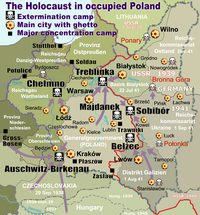
Back Vernichtungslager ALS معسكر إبادة Arabic Ölüm düşərgəsi Azerbaijani নির্মূল শিবির Bengali/Bangla Kamp-diouennañ Breton Camp d'extermini Catalan کۆمەڵگەی لەناوبردن CKB Vyhlazovací tábor Czech Gwersyll difa Welsh Udryddelseslejr Danish
| Nazi extermination camps | |
|---|---|
 View of Sobibor extermination camp, 1943
 The Holocaust map: The six Nazi extermination camps set up by the SS in occupied Poland, are marked with white skulls in black squares. | |
| Location | German-occupied Europe (chiefly occupied Poland) |
| Date | World War II |
| Incident type | Extermination |
| Perpetrators | The SS |
| Organizations | SS-Totenkopfverbände |
| Camp | Chełmno, Bełżec, Sobibór, Treblinka, Auschwitz-Birkenau, Majdanek |
Nazi Germany used six extermination camps (German: Vernichtungslager), also called death camps (Todeslager), or killing centers (Tötungszentren), in Central Europe, primarily Occupied Poland, during World War II to systematically murder over 2.7 million people – mostly Jews – in the Holocaust.[1][2][3] The victims of death camps were primarily murdered by gassing, either in permanent installations constructed for this specific purpose, or by means of gas vans.[4] The six extermination camps were Chełmno, Belzec, Sobibor, Treblinka, Majdanek and Auschwitz-Birkenau. Extermination through labour was also used at the Auschwitz and Majdanek death camps.[5][6][4] Millions were also murdered in concentration camps, in the Aktion T4, or directly on site.[7]
The idea of mass extermination with the use of stationary facilities, to which the victims were taken by train, was the result of earlier Nazi experimentation with chemically manufactured poison gas during the secretive Aktion T4 euthanasia programme against hospital patients with mental and physical disabilities.[8] The technology was adapted, expanded, and applied in wartime to unsuspecting victims of many ethnic and national groups; the Jews were the primary target, accounting for over 90 percent of extermination camp victims.[9] The genocide of the Jews of Europe was Nazi Germany's "Final Solution to the Jewish question".[10][4][11]
- ^ "World War II and the Holocaust, 1939–1945". United States Holocaust Memorial Museum. Retrieved 7 June 2020.
- ^ "The Death Camps". Yad Vashem. Retrieved 3 April 2020.
- ^ "Killing Centers: An Overview". Holocaust Encyclopedia. United States Holocaust Memorial Museum. Retrieved 3 April 2020.
- ^ a b c "The Implementation of the Final Solution: The Death Camps". The Holocaust. Yad Vashem, The World Holocaust Remembrance Center. Retrieved 20 April 2020.
- ^ Gruner, Wolf (April 2004). "Jewish Forced Labor as a Basic Element of Nazi Persecution: Germany, Austria, and the Occupied Polish Territories (1938–1943)". Forced and Slave Labor in Nazi-Dominated Europe (PDF). Washington, D.C.: Center for Advanced Holocaust Studies, United States Holocaust Memorial Museum. pp. 43–44. Symposium.
- ^ Gellately, Robert; Stoltzfus, Nathan (2001). Social Outsiders in Nazi Germany. Princeton, New Jersey: Princeton University Press. p. 216. ISBN 978-0-691-08684-2.
- ^ Orth 2009a, p. 194.
- ^ Holocaust Encyclopedia (20 June 2014). "Gassing Operations". United States Holocaust Memorial Museum, Washington, DC. Retrieved 25 January 2015.
- ^ Russell, Shahan (12 October 2015). "The Ten Worst Nazi Concentration Camps". WarHistoryOnline.com. Archived from the original on 22 July 2019. Retrieved 20 October 2017.
- ^ Furet, François (1989). Unanswered Questions: Nazi Germany and the Genocide of the Jews. New York: Schocken Books. p. 182. ISBN 978-0805209082.
- ^ Bergen, Doris (2004–2005). "Nazi Ideology and the Camp System". Auschwitz: Inside the Nazi State. Community Television of Southern California.